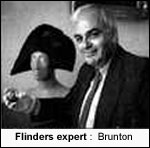
TRANSCRIPTION
The man who put Australia on the map
 Paul
Brunton on why Flinders' map of Australia is so important
Paul
Brunton on why Flinders' map of Australia is so important
WHEN we look at the map of Australia, we are looking at the memorial of the great naval explorer Matthew Flinders. He drew the first map of Australia in 1804 while held in detention by the French on Mauritius.
Flinders had just circumnavigated the Australian continent, from 1801 to 1803, and had charted Tasmania with George Bass in 1798-99. He had proven that the east, charted by James Cook in 1770, was the same landmass as the west, surveyed by Dutch navigators during the 17th century. He had demonstrated that Tasmania was an island separated from the mainland by a navigable strait. His map of these discoveries was the summary of his life's work. At last, the mystery of the great south land was solved.
His map, though, was an unfinished work. Flinders did sail right around the continent but he had been unable, owing to the rotten condition of his ship, the Investigator, to chart the north and west coasts from the Wessel Islands, off northeast Arnhem Land, to Cape Leeuwin, the southwestern tip of Western Australia. To trace that coastline on his map, he relied on the charts of earlier Dutch navigators Abet Tasman in 1644 and Willem de Vlamingh in 1697.
Flinders boldly titled his map "Australia or Terra Australis". The word "Australia' had intermittently been used from the early 17th century to describe indeterrninate land masses in the southern hemisphere and had once, in the forms Greater and Lesser Australia, been used to describe a vast swath of the east coast and Pacific islands.
But it was Flinders who first attached the word to the entity he had charted.
He was held captive by the French on Mauritius, suspected of spying for Britain, until 1810, deeply frustrated that his charts remained unpublished. His general chart of Australia and 14 detailed charts of sections of the coastline were finally published in London in July 1814, the month of his death at the age of 40.
He lost the battle to retain on this general chart the title "Australia or Terra Australis", in that order, but was allowed to reverse it: "Term Australis or Australia". He had to fight even for this as "New Holland" was the name hallowed by precedent, even though this name did not reflect the British contribution. For centuries, the presumed southern continent had been called "terra australis incognita", Latin for "the unknown southern land". Flinders thought the term "terra australis', at least, did not give all the credit to the Dutch.
"Australia" was on the map though, even if in a subordinate position. When Governor Lachlan Macquarie received Flinders' chart in 1817, he decided "Australia" was the appropriate name and began using it in his writings, giving it official sanction, and leading to its general use. No national map is so identified with a single person as is the map of Australia.
This is not only because Flinders defined the geographical limits of our nation and gave us its name. It is also because he named hundreds of places around Australia, many more than any other individual.
Flinders bestowed two of the most recognised names on the map: Great Australian Bight and Great Barrier Reef. He named other places after those who had helped his career; after those who might still be of assistance; after family; friends and colleagues; and in honour of previous voyages of discovery. He personalised the map in a way that no other nation's map is personalised, reflecting the life of one man. But he named nothing after himself and where his name now appears on our map it does so because others have later honoured him.
Paul Brunton is the curator of Matthew Flinders. The Ultimate Voyage, the touring exhibition of the State Library of NSW. The exhibition moves to the State Library of Victoria on January 29.



